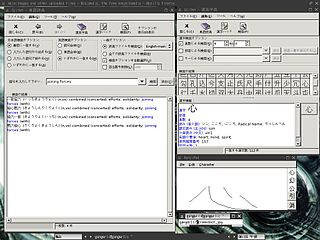 W
WEijirō (英辞郎) is a very large database of English–Japanese translations. Developed by the editors of the Electronic Dictionary Project and aimed at translators, Eijirō is currently one of the most popular dictionaries on the Internet. Although the contents are technically the same, EDP refers to the accompanying Japanese–English database as Waeijirō (和英辞郎).
 W
WGjiten is a free software dictionary application developed for Linux operating systems, using the GNOME development libraries. It functions primarily as a Japanese–English dictionary tool meant to search EDICT dictionary files, but it has other features such as hand-drawn kanji recognition. It was first published on December 25, 1999. Its current release is v2.6, available since October 28, 2006. The source code is downloadable from the developers' website.
 W
WFirst published in 1918, Kenkyusha’s New Japanese-English Dictionary has long been the largest and most authoritative Japanese-English dictionary. Translators, scholars, and specialists who use the Japanese language affectionately refer to this dictionary as the Green Goddess or (GG) because of its distinctive dark-green cover.
 W
WKiten is a Japanese Kanji learning tool and reference for the KDE Software Compilation, specifically, in the kdeedu package. It also works as a Japanese-to-English and English-to-Japanese dictionary. The user can input words into a search box, and all related Kanji are returned with their meaning and part of speech. Kanji can be filtered by rarity and part of speech. A list of Kanji is also available which sorts characters by grade level and stroke number. Selecting one shows its Onyomi, Kunyomi, and meanings. Users can also add Kanji to their "learn list" and get simple flashcard quizzes where the Kanji is displayed along with possible meanings to choose from.
 W
WThe Kodansha Kanji Learner's Dictionary is a kanji dictionary based on the New Japanese-English Character Dictionary by Jack Halpern at the CJK Dictionary Institute and published by Kenkyūsha. Originally published in 1999, a revised and updated Second Edition was issued on 2013, reflecting the new changes in the Joyo Kanji mandated in 2010. This Revised and Expanded Edition increases the number of kanji entries from 2,230 to 3,002, as well as changing all pronunciations from romaji to kana. There also exists electronic forms of this dictionary for both iOS and Android. A more extensive version of this dictionary by the CJK Dictionary Institute is also published by Kodansha called the Kodansha Kanji Dictionary.
 W
WKōjien is a single-volume Japanese dictionary first published by Iwanami Shoten in 1955. It is widely regarded as the most authoritative dictionary of Japanese, and newspaper editorials frequently cite its definitions. As of 2007, it had sold 11 million copies.
 W
WThe New Nelson Japanese-English Character Dictionary is a kanji dictionary published with English speakers in mind. It is an updated version of the original dictionary authored by Andrew N. Nelson, The Modern Reader's Japanese-English Character Dictionary. The primary change in the new version is the adoption of the traditional 214 Kangxi radicals as the dictionary's main indexing method. The dictionary also features two additional indices: the Universal Radical Index and the on-kun index.
 W
WNichi-Ran jiten is a Japanese–Dutch dictionary compiled by Peter Adriaan van de Stadt and originally published by the Taiwanese branch of Nan'yō Kyōkai in 1934. It has about 33,800 entries. As of 2011, a second edition has not been published, but at least one facsimile edition was published in 1989 by the current Nan'yō Kyōkai, now based in Tokyo.
 W
WThe Ruiju myōgishō , alternatively misread as Ruijū myōgishō, is a Japanese dictionary from the late Heian Period. The title, sometimes abbreviated as Myōgishō, combines the ruiju from the Wamyō Ruijushō and the myōgi from the Tenrei Banshō Myōgi. Additional Buddhist titles, like Sanbō ruiju myōgishō (三宝類聚名義抄), use the word sanbō because the text was divided into butsu, hō, and sō sections.
 W
WThe Wamyō ruijushō or Wamyō ruijūshō is a 938 CE Japanese dictionary of Chinese characters. The Heian period scholar Minamoto no Shitagō began compilation in 934, at the request of Emperor Daigo's daughter. This Wamyō ruijushō title is abbreviated as Wamyōshō, and has graphic variants of 和名類聚抄 with wa 和 "harmony; Japan" for wa 倭 "dwarf; Japan" and 倭名類聚鈔 with shō 鈔 "copy; summarize" for shō 抄 "copy; annotate".